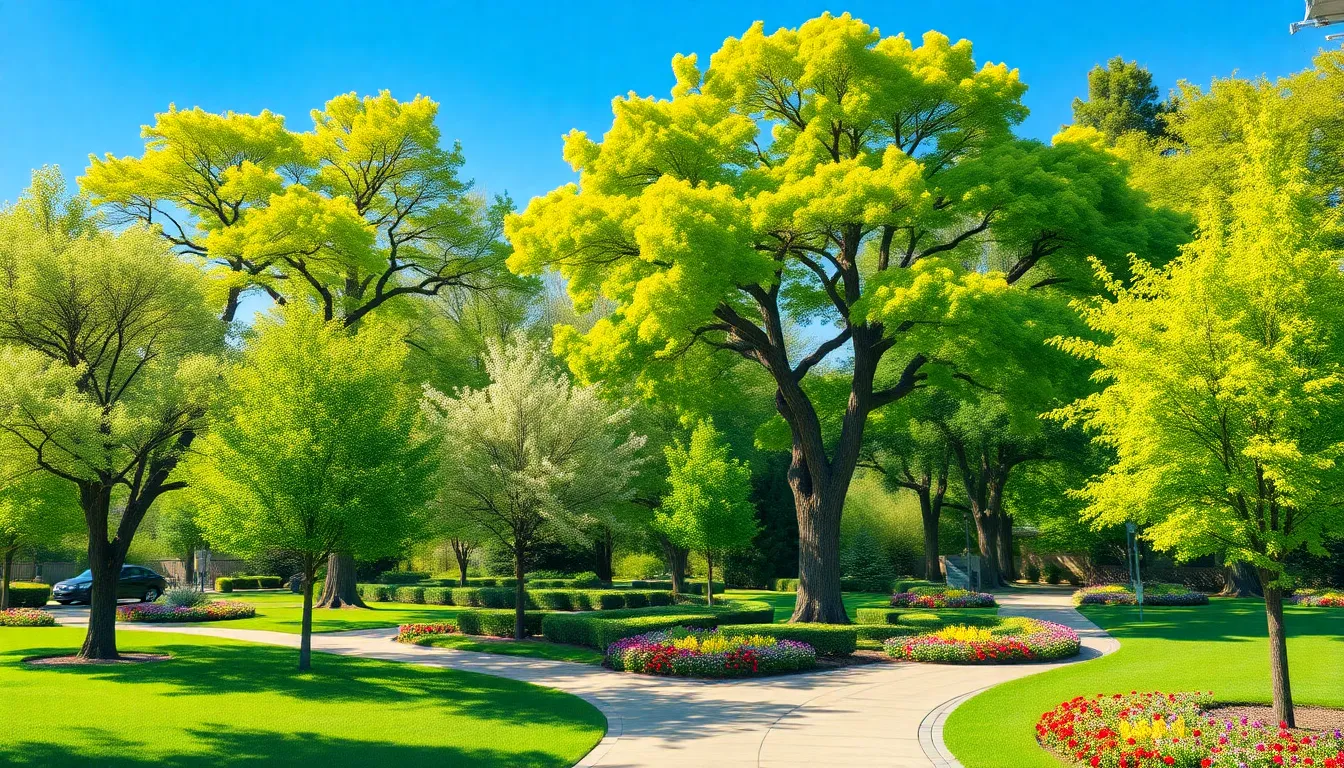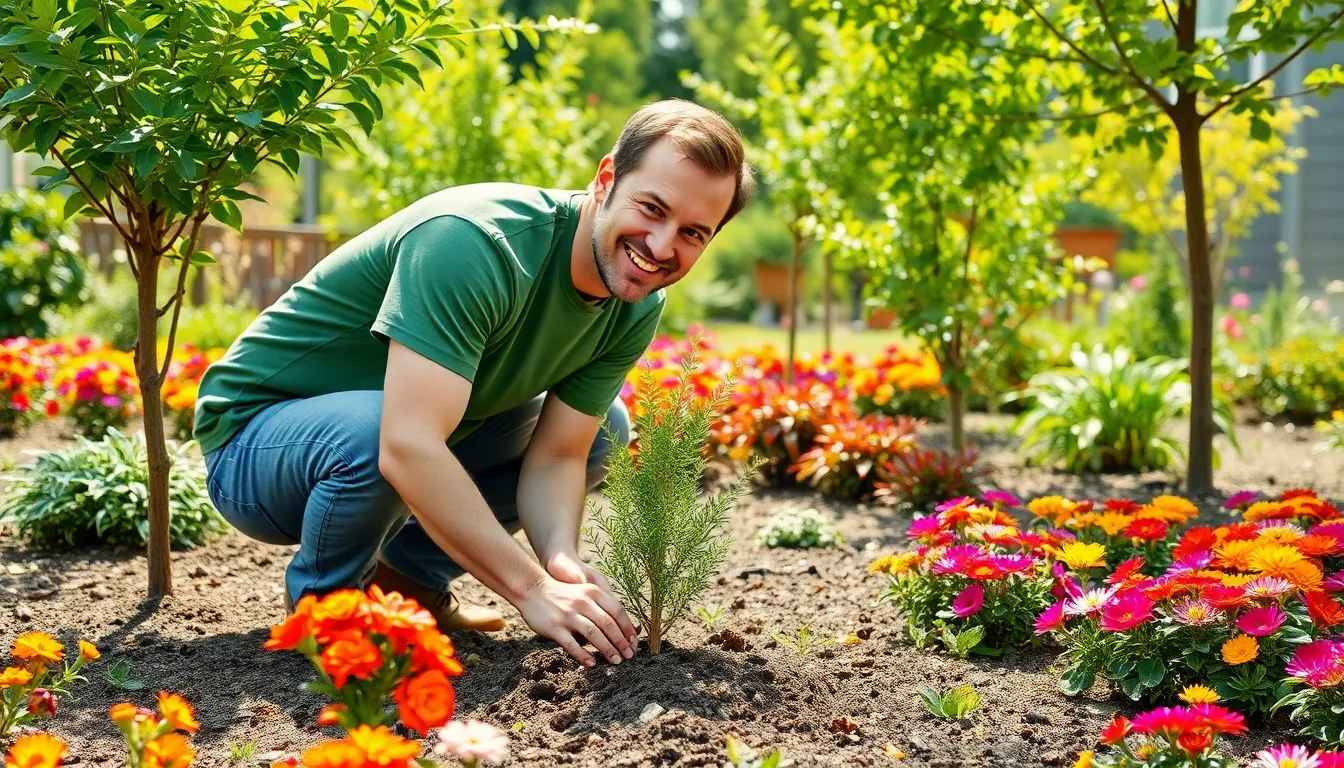Imagine transforming your yard into a lush oasis where trees sway like they’re dancing to their own tune. Tree landscaping isn’t just about planting a few saplings and hoping for the best; it’s an art form that can elevate any outdoor space from drab to fab. With the right trees, you can create a stunning backdrop for family barbecues or a cozy nook for sipping coffee on lazy Sunday mornings.
But let’s face it—picking the perfect trees can feel like a game of roulette. Do you go for the majestic oak or the whimsical cherry blossom? Fear not! This guide will help you navigate the leafy labyrinth of tree landscaping, ensuring your yard becomes the envy of the neighborhood. Get ready to dig in and discover how to cultivate a thriving landscape that’s as delightful as it is functional.
Tree Landscaping
Tree landscaping involves strategically selecting and placing trees to enhance outdoor environments. This practice transforms yards into vibrant ecosystems, providing visual appeal and functional benefits. Focal points arise from well-placed trees, drawing attention and creating structure in landscaping designs.
Growing trees provide shade, improve air quality, and contribute to property values. Careful consideration is essential for choosing tree species that thrive in specific climates and soil types. Some trees, like oaks or maples, offer seasonal beauty, while evergreens provide year-round structure.
Successful tree landscaping requires planning. Understanding the growth patterns of trees aids in determining the optimal distance for planting. Adequate spacing allows for healthy growth and minimizes competition for sunlight and nutrients. Selecting dwarf varieties may suit smaller spaces, while larger areas benefit from tall trees, adding layers to the landscape.
Additionally, incorporating native trees helps support local wildlife and promotes biodiversity. These species adapt well to the environment, requiring less maintenance and conserving water. Choosing fruit-bearing trees can further enhance a yard, offering seasonal harvests alongside aesthetic value.
Sustainability plays a critical role in tree landscaping. Selecting trees with lower water needs and pest resistance reduces the demand for chemical treatments. Smart tree placement also minimizes the need for extensive landscaping upkeep, providing an eco-friendly approach to outdoor design.
By keeping these principles in mind, individuals can create beautiful, functional outdoor spaces that reflect personal tastes and enhance overall quality of life.
Benefits of Tree Landscaping

Tree landscaping offers significant advantages for both the environment and aesthetics of outdoor spaces. A well-planned tree landscape enhances property value and contributes to ecological sustainability.
Environmental Impact
Trees play a crucial role in air quality improvement. They absorb carbon dioxide and release oxygen, ensuring cleaner air for surrounding habitats. Additionally, trees provide essential shade, which helps reduce energy costs by lowering indoor temperatures. They also mitigate soil erosion, supporting a stable ecosystem. Wildlife thrives near diverse tree species, enhancing local biodiversity. Furthermore, trees contribute to stormwater management by absorbing rainwater and reducing runoff.
Aesthetic Value
An eye-catching tree landscape adds charm and character to any property. Trees come in various shapes, colors, and sizes, allowing for tailored design that complements architectural features. Seasonal changes create dynamic visual interest throughout the year as colorful foliage displays emerge in spring and autumn. Strategically placed trees can frame views, highlight focal points, and create inviting pathways. These elements not only enhance outdoor enjoyment but also encourage outdoor activities and social interaction.
Tree Selection for Landscaping
Selecting the right trees significantly enhances outdoor aesthetics and functionality. Thoughtful choices lead to thriving ecosystems that support biodiversity.
Native vs. Non-Native Trees
Native trees thrive in local environments, offering food and shelter for indigenous wildlife. By prioritizing these species, individuals promote resilience and sustainability within their landscapes. Consider black oak and red maple as excellent native choices. Non-native trees, while often beautiful, may disrupt local ecosystems and require more maintenance. Examples include ornamental cherry and crabapple, which, although appealing, sometimes struggle in unfamiliar soils.
Considerations for Climate and Soil
Climate dictates what trees will flourish in a specific location. For example, areas with intense heat benefit from drought-tolerant species like desert willow. Soil type also plays a crucial role; loamy soils support a wide variety of trees, while sandy or clay soils may limit options. Testing soil pH ensures compatibility with tree requirements, facilitating healthy growth. Select trees that match specific climate and soil conditions to optimize longevity and overall performance.
Techniques in Tree Landscaping
Tree landscaping employs various techniques that enhance both the beauty and health of trees in outdoor spaces.
Pruning and Maintenance
Pruning plays a crucial role in tree health and aesthetics. It involves removing dead or diseased branches to promote growth and improve air circulation. Regular maintenance also includes inspecting trees for pests and diseases, ensuring early intervention when necessary. Adjusting watering schedules based on seasonal weather patterns fosters strong root systems. Mulching around the base helps retain soil moisture and suppresses weeds. These practices together create a thriving environment for trees, increasing their lifespan and visual appeal.
Strategic Planting
Strategic planting maximizes the benefits of tree landscaping. Understanding the specific sunlight and water needs of each species allows for optimal placement. Grouping trees with similar requirements minimizes competition for resources. Utilizing natural windbreaks enhances overall landscape resilience. Creating a layered effect with taller trees at the back and smaller ones in front adds depth and visual interest. Assessing soil conditions and local climate ensures the chosen trees thrive in their designated spaces, promoting a healthy ecosystem.
Common Challenges in Tree Landscaping
Tree landscaping presents challenges that require careful consideration. One common issue is choosing the right species for specific environments. Selecting trees that aren’t suited for local soil and climate can lead to unhealthy growth or failure to thrive.
Space constraints pose another significant challenge. Limited room for root expansion can hinder tree development and cause instability. Inspecting surrounding structures and plants ensures adequate spacing to prevent competition for resources.
Tree maintenance, including pruning and pest management, proves essential. Regular upkeep prevents disease and promotes healthy growth. Identifying pests early can minimize damage and maintain tree vitality.
Environmental factors also affect tree landscaping. Drought conditions can lead to water stress, while heavy rainfall may cause root rot. Using drought-tolerant species can alleviate concerns in arid areas. Smart irrigation systems can help manage water consumption effectively.
Planting technique influences tree success. Understanding light and water needs enables better placement in the landscape. Grouping trees with similar requirements simplifies care.
Diseases represent another hurdle for tree landscapes. Fungal infections and bacterial issues can devastate tree populations. Implementing a proactive pest management strategy can help protect tree health.
Landscape design complexity adds to these challenges. Creating visually appealing arrangements demands knowledge of tree sizes and shapes. Misjudging growth patterns can lead to overcrowding or imbalance in aesthetics.
Collaboration with professionals can enhance tree landscaping efforts. Landscape architects and arborists provide expertise in design and species selection. Their guidance can navigate challenges and ensure a successful tree landscape.
Conclusion
Tree landscaping offers a unique opportunity to create stunning outdoor spaces that benefit both the environment and the homeowner. By thoughtfully selecting and placing trees, individuals can enhance the beauty of their properties while supporting local ecosystems. Emphasizing native and drought-tolerant species not only reduces maintenance needs but also fosters biodiversity.
A well-executed tree landscape enriches the aesthetic appeal of a yard and contributes to improved air quality and energy savings. Regular maintenance and strategic planting ensure that trees thrive, creating a vibrant and inviting atmosphere. With the right approach, tree landscaping can transform any outdoor area into a cherished retreat that brings joy and satisfaction for years to come.





